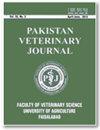求助PDF
{"title":"Pharmacokinetics of Cefquinome in Layer Birds Following Intramuscular and Intravenous Administration","authors":"R. Saleem","doi":"10.29261/pakvetj/2019.065","DOIUrl":null,"url":null,"abstract":"Received: Revised: Accepted: Published online: February 19, 2019 April 02, 2019 April 14, 2019 April 26, 2019 Cefquinome is approved for use against many bacterial infections in a number of animal species. This study was conducted to evaluate the pharmacokinetics of Cefquinome after intramuscular (IM) and intravenous (IV) administration in layer birds for its safety evaluation. Twelve healthy layer birds were randomly allocated in two equal groups. Each group was administered with 5mg/kg b.w. of Cefquinome by intramuscular and intravenous routes. Highly sensitive high performance liquid chromatography with ultraviolet detection (HPLC-UV) method was developed for quantification of Cefquinome in layer bird’s plasma with >80% recovery. The Limit of detection and quantification were 0.02 and 0.05μg/ml, respectively. The pharmacokinetic data showed that mean Area under the curve (AUC) after IM and IV administration were 7.838±0.165 and 11.729±0.346h×μg/ml, respectively. The maximum concentration (Cmax) following IM administration (4.525±0.129 μg/ml) was almost same the mean Cmax after IV administration (4.635±0.270μg/ml). Time to reach maximum concentration (Tmax) after IV and IM administration were 0.1h and 0.5h, respectively. Cefquinome sulphate had a relatively shorter half-life (1.19±0.14h) after IV dose administration. The shorter half-life depicts a rapid elimination. Total recovery after each administration was greater than 75%. The mean resident time after IM and IV administration was found to be 1.528±0.09h and 1.988±0.0311h, respectively. The bioavailability after IM administration was 66.84±2.05%. This study indicated that Cefquinome sulphate has favorable pharmacokinetics following both administrations in healthy layer birds which can help to form optimum dosage regimes thus ultimately leading to its use for eradication of various systemic and local infections. ©2019 PVJ. All rights reserved","PeriodicalId":19845,"journal":{"name":"Pakistan Veterinary Journal","volume":" ","pages":""},"PeriodicalIF":3.8000,"publicationDate":"2019-10-01","publicationTypes":"Journal Article","fieldsOfStudy":null,"isOpenAccess":false,"openAccessPdf":"","citationCount":"2","resultStr":null,"platform":"Semanticscholar","paperid":null,"PeriodicalName":"Pakistan Veterinary Journal","FirstCategoryId":"97","ListUrlMain":"https://doi.org/10.29261/pakvetj/2019.065","RegionNum":3,"RegionCategory":"农林科学","ArticlePicture":[],"TitleCN":null,"AbstractTextCN":null,"PMCID":null,"EPubDate":"","PubModel":"","JCR":"Q1","JCRName":"VETERINARY SCIENCES","Score":null,"Total":0}
引用次数: 2
引用
批量引用
肌肉和静脉给药后头孢醌在蛋鸡体内的药代动力学
接收日期:修订日期:接受日期:在线发布日期:2019年2月19日2019年4月02日2019年04月14日2019年06月26日头孢喹酮被批准用于治疗多种动物的许多细菌感染。本研究旨在评估头孢醌在蛋鸡肌肉内(IM)和静脉内(IV)给药后的药代动力学,以进行安全性评估。12只健康的蛋鸡被随机分为两组。每组通过肌肉注射和静脉注射给药5mg/kg b.w.头孢喹酮。建立了高效液相色谱-紫外检测(HPLC-UV)法测定蛋鸡血浆中头孢醌的含量,回收率>80%。检测限和定量限分别为0.02和0.05μg/ml。药代动力学数据显示,IM和IV给药后的平均曲线下面积(AUC)分别为7.838±0.165和11.729±0.346h×μg/ml。IM给药后最大浓度(Cmax)(4.525±0.129μg/ml)与IV给药后平均Cmax(4.635±0.270μg/ml)几乎相同。IV和IM给药达到最大浓度(Tmax)的时间分别为0.1h和0.5h。静脉给药后,硫酸头孢醌的半衰期相对较短(1.19±0.14小时)。半衰期较短,说明迅速消除。每次给药后的总回收率大于75%。IM和IV给药后的平均停留时间分别为1.528±0.09h和1.988±0.0311h。IM给药后的生物利用度为66.84±2.05%。本研究表明,硫酸头孢醌在健康蛋鸡中两次给药后具有良好的药代动力学,这有助于形成最佳剂量方案,从而最终用于根除各种全身和局部感染。©2019 PVJ。保留所有权利
本文章由计算机程序翻译,如有差异,请以英文原文为准。


